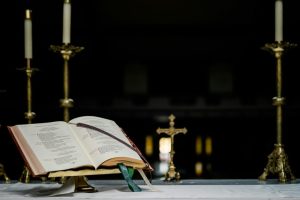Anyone who’s seen The King’s Speech, about King George VI and his speech therapist, knows people don’t stutter when they sing. So will singing similarly help Mass-goers with the words of the new missal translation?
Composer Steven Warner says yes. Singing will keep people from slipping back into the familiar words of the old translation. He sings a demonstration of the new “The Lord be with you” and its response, “And with your spirit.”
That is a word-for-word translation of the Latin: “Et cum spiritu tuo,” bringing English-speaking Catholics much closer to their Spanish-speaking fellow parishioners who respond, “Y con tu espíritu.”
No doubt that’s at least part of the reason Spanish-speaking composers seem especially enthusiastic about the changes. “It brings more unity to what we’re doing bilingually,” says Santiago Fernández, who is both a composer and music director of three combined parishes in Pontiac, Michigan. “I think it’s a wonderful opportunity to praise, to come together with the same text. We’re doing this for the right reasons.”
The musical changes are substantial or minor, depending on how they’re counted. While most of the sung portions of the Mass (put to music in various Mass settings) remain the same, three key sections differ: the Holy, Holy, or Sanctus; the Glory to God, or Gloria; and the memorial acclamations. The most popular of those acclamations, “Christ has died, Christ is risen, Christ will come again,” used only in the United States, has been eliminated completely.
Music directors will find help from the U.S. Conference of Catholic Bishops, professional organizations, and their dioceses. All three major Catholic music publishers and some individual composers are offering resources to support music ministers with the new music.
Oregon Catholic Press, for instance, sent out a packet to every parish in the country this January. It included a CD of new and revised Mass settings and a booklet with the revised Order of Mass. GIA Publications produced videos of composer David Haas explaining the new Mass settings and offering suggestions. World Library Publications composer Warner, who also leads the folk choir at Notre Dame University, has crisscrossed the country offering workshops for music directors.
All three publishers are offering so many new and revised Mass settings (which can be heard at their websites) that the question has become how to choose from among all the new Mass settings.
Most music directors seem to be going with one new Mass setting and one familiar, revised setting—a common-sense solution considering how attached parishioners are to their music and the fact that most of the sections are unchanged.
Composers, though, are arguing against revising familiar Mass settings. “My concern with the revised Mass settings is if you start out with two measures of what they already knew, then depart from it, you’re manufacturing a train wreck,” says Warner.
Fernández says that as a musician he knows it’s easier to learn a new song from scratch rather than try to relearn an old piece differently. “We should take this opportunity to learn something new and exciting.”
In his role as a member of the Detroit Diocesan Worship Commission, Fernández has created a chart of the new and revised Mass settings for music ministers. It illustrates which settings have more of a traditional feel, which are contemporary, which are arranged for just a choir without accompaniment, and so on.
Michael McMahon, president of the National Association of Pastoral Musicians, urges music directors to begin studying the new and revised Mass settings in order to get to know them. Composer Haas, on that GIA video, suggests music directors at that point call a town meeting, perhaps even with nearby parishes, devoted to singing and learning about the new and revised settings. People can vote for their favorites.
Many parishes are offering classes. McMahon says that the musical changes will raise questions, and it will be up to music directors to have answers. He urges music ministers to focus on the positive, that the new translation will force everyone to pay attention and go back to basics.
Jaime Cortez, a composer and the director of liturgy and music at Holy Cross Church in Mesa, Arizona, sees his role in the upcoming transition as being a catechist. “I’m going to calm people’s fears,” he says. “I’m going to be a voice that will proclaim an opportunity for a better understanding of the liturgy that will deepen faith. I’m going to try to do it as gracefully as possible.”
Enthusiasm aside, the changes will be unsettling. “It will be like getting up in the middle of the night and finding the furniture’s been rearranged,” Warner says. “We’ll need to be patient because we’ll all make mistakes.”
Catholic musicians will overcome the difficulties, McMahon says. “Of all the ministers, musicians tend to be the happiest,” he claims. “Most are can-do people. They know how to make things work.”
Owen Alstott, who composed the popular Heritage Mass (which has been revised to fit the new translations), predicts that this uncomfortable transition will result in churches again being filled with new, beautiful music, composed by all the talented young composers now writing new Mass settings.
So expect to find yourself singing “And with your spirit,” with little worry about slipping back into “And also with you.”
Leaving just one question: Will it also help with “consubstantial”?
This article appeared in the May 2011 issue of U.S. Catholic (Vol. 76, No. 5, page 16).












Add comment